China’s Input-Output Efficiency of Water-Energy-Food Nexus Based on the Data Envelopment Analysis (DEA) Model
Abstract
:1. Introduction
2. The DEA Model
2.1. The Essential Definition
2.2. The C2R and BC2 Model
2.2.1. The C2R Model
- (1)
- If , and in Equation (2), then DMU is DEA efficiency;
- (2)
- If , then DMU is weak DEA efficiency; and
- (3)
- If , then DMU is no DEA efficiency, which means that the DMU does not reach a proper ratio.
2.2.2. The BC2 Model
2.3. The Malmquist Index Model
2.4. Applicability of the DEA Model in WEF-Nexus
3. Input-Output Index System
3.1. Economic Implications of Input-Output Efficiency
3.2. Selection of Input and Output Indexes
3.3. Verification of the Validity in Index System
3.4. Data Preprocessing
4. Results and Outcomes
4.1. DEA Model Results
4.2. Malmquist Index Results
5. Discussion
6. Conclusions and Suggestions for Future Research
Acknowledgments
Author Contributions
Conflicts of Interest
References
- World Economic Forum. Global Risks 2011 Report, 6th ed.; World Economic Forum: Cologne, Germany, 2011. [Google Scholar]
- Hoff, H. Understanding the Nexus: Background Paper for the Bonn 2011 Conference: The Water, Energy and Food Security Nexus; Stockholm Environment Institute: Stockholm, Sweden, 2011. [Google Scholar]
- Howells, M.; Hermann, S.; Welsch, M.; Bazilian, M.; Segerstrom, R.; Alfstad, T.; Gielen, D.; Rogner, H.; Fischer, G.; Van Velthuizen, H.; et al. Integrated analysis of climate change, land-use, energy and water strategies. Nat. Clim. Chang. 2013, 3, 621–626. [Google Scholar] [CrossRef]
- Ringler, C.; Bhaduri, A.; Lawford, R. The nexus across water, energy, land and food (WELF): Potential for improved resource use efficiency. Curr. Opin. Environ. Sustain. 2013, 5, 617–624. [Google Scholar] [CrossRef]
- Wong, J.L. The Food-Energy-Water Nexus: An Integrated Approach to Understanding China’s Resource Challenges. Harv. Asia Quart. 2010, 12, 15–19. [Google Scholar]
- Foran, T. Node and Regime: Interdisciplinary analysis of water-energy-food nexus in the Mekong region. Water Altern. 2015, 8, 665–674. [Google Scholar]
- Gulati, M.; Jacobs, I.; Jooste, A.; Naidoo, D.; Fakir, S. The water-energy-food security nexus: Changes and opportunities for food security in South Africa. Aquat. Procedia 2013, 1, 150–164. [Google Scholar] [CrossRef]
- Sahin, O.; Stewart, R.A.; Richards, R.G. Addressing the water-energy-climate nexus conundrum: A system approach. In Proceedings of the 7th International Congress on Environment Modelling and Software, San Diego, CA, USA, 15–19 June 2014.
- Chang, Y.; Li, G.; Yao, Y.; Zhang, L.; Chang, Y. Quantifying the Water-Energy-Food Nexus: Current Status and Trends. Energies 2016, 9, 1–17. [Google Scholar] [CrossRef]
- Keskinen, M.; Someth, P.; Salmivaara, A.; Kummu, M. Water-Energy-Food Nexus in a Transboundary River Basin: The Case of Tonle Sap Lake, Mekong River Basin. Water 2015, 7, 5416–5436. [Google Scholar] [CrossRef]
- Karabulut, A.; Egoh, B.N.; Lanzanova, D.; Grizzetti, B.; Bidoglio, G.; Pagliero, L.; Bouraoui, F.; Aloe, A.; Reynaud, A.; Maes, J.; et al. Mapping water provisioning services to support the ecosystem-water-food-energy nexus in the Danube river basin. Ecosyst. Serv. 2016, 17, 278–292. [Google Scholar] [CrossRef]
- Allouche, J.; Middleton, C.; Gyawali, D. Technical veil, hidden politics: Interrogating the power linkages behind the nexus. Water Altern. 2015, 8, 610–626. [Google Scholar]
- Mohtar, R.H.; Daher, B. Water-energy-food nexus framework for facilitating multi-stakeholder dialogue. Water Int. 2016. [Google Scholar] [CrossRef]
- Mohtar, R.H.; Lawford, R. Present and future of the water-energy-food nexus and the role of the community of practice. J. Environ. Stud. Sci. 2016, 6, 192–199. [Google Scholar] [CrossRef]
- Scott, C.A.; Kurian, M.; Wescoat, J.L., Jr. The Water-Energy-Food Nexus: Enhancing Adaptive Capacity to Complex Global Challenges. In Governing the Nexus: Water, Soil and Waste Resources Considering Global Change; Kurian, M., Ardakanian, R., Eds.; Springer International Publishing: Cham, Switzerland, 2015; pp. 15–38. [Google Scholar]
- Larson, D.F. Introducing water to an analysis of alternative food security policies in the Middle East and North Africa. Aquat. Procedia 2013, 1, 30–43. [Google Scholar] [CrossRef]
- Soliev, I.; Wegerich, K.; Kazbekov, J. The Costs of Benefit Sharing: Historical and Institutional Analysis of Shared Water Development in the Ferghana Valley, the Syr Darya Basine. Water 2015, 7, 2728–2752. [Google Scholar] [CrossRef]
- Endo, A.; Burnett, K.; Orencio, P.M.; Kumazawa, T.; Wada, C.A.; Ishii, A.; Tsurita, I.; Taniguchi, M. Methods of the Water-Energy-Food Nexus. Water 2015, 7, 5806–5830. [Google Scholar] [CrossRef]
- Liao, H.C.; Dong, Y.M. Utilization efficiency of water resources in 12 western provinces of China based on the DEA and Malmquist TFP index. Resour. Sci. 2011, 33, 273–279. [Google Scholar]
- Qiu, L.; Shen, Y.M.; Ren, W.B.; Yan, T.T. Analysis on regional disparity and its influential factors of energy utilization efficiency in China. J. Nat. Resour. 2008, 28, 920–929. [Google Scholar]
- Haie, N. Sefficiency (sustainable efficiency) of water-energy-food entangled systems. Int. J. Water Resour. Dev. 2015. [Google Scholar] [CrossRef]
- Walker, R.V.; Beck, M.B.; Hall, J.W.; Dawson, R.J.; Heidrich, O. The energy-water-food nexus: Strategic analysis of technologies for transforming the urban metabolism. J. Environ. Manag. 2014, 141, 104–115. [Google Scholar] [CrossRef] [PubMed]
- Mi, H.; Zhou, W. The system simulation of China’s grain, fresh water and energy demand in the next 30 years. Popul. Econ. 2010, 31, 1–7. [Google Scholar]
- Daher, B.T.; Mohtar, R.H. Water-energy-food (WEF) nexus tool 2.0: Guiding integrative resource planning and decision-making. Water Int. 2015, 40, 748–771. [Google Scholar] [CrossRef]
- Wei, Q.L. Data Envelopment Analysis; Science Press: Beijing, China, 2004; pp. 2–20. [Google Scholar]
- Li, Z.F.; Li, Y.L. An empirical study on performance evaluation of infrastructure investment of China based on DEA method from 2003 to 2007. J. Syst. Manag. 2009, 18, 309–315. [Google Scholar]
- Cooper, W.W.; Seiford, L.M.; Tone, K. Data Envelopment Analysis; Kluwe Academic Publishers: Boston, MA, USA, 2000. [Google Scholar]
- Chen, Y.W. Evaluation on the efficiency of the input and output of science and technology based on composite DEA and Malmquist Index. Oper. Res. Manag. Sci. 2011, 20, 196–204. [Google Scholar]
- Liu, H.M.; Deng, J.G. Review on the two paradigms of research on sustainable development theory. Econ. Rev. 2010, 20, 874–907. [Google Scholar]
- Zeng, Z.X.; Gu, P.L. System Analysis and Evaluation on Sustainable Development; Science Press: Beijing, China, 2000. [Google Scholar]
- Bhaduri, A.; Ringler, C.; Dombrowski, I.; Mohtar, R.; Scheumann, W. Sustainability in the water-energy-food nexus. Water Int. 2015, 40, 723–732. [Google Scholar] [CrossRef]
- Ferroukhi, R.; Nagpal, D.; Lopez-Peña, A.; Hodges, T.; Mohtar, R.H. Renewable Energy in the Water, Energy & Food Nexus; International Renewable Energy Agency (IRENA): Abu Dhabi, United Arab Emirates, 2015. [Google Scholar]
- Qian, W.J.; He, C.F. China’s regional difference of water resource use efficiency and influencing factors. China Popul. Resour. Environ. 2011, 11, 54–60. [Google Scholar]
- Li, G.P.; Guo, J. The study of the ecological environment restoration in energy-rich region. China Popul. Resour. Environ. 2013, 23, 42–48. [Google Scholar]
- Shi, P.H.; Fang, C.L.; Chen, T.B. Sustainable development: grain production, natural resource and environment in China. China Popul. Resour. Environ. 1998, 8, 69–74. [Google Scholar]
- Liu, C.M.; Wang, H.R. An analysis of the relationship between water resources and population-economy-society-environment. J. Nat. Resour. 2003, 18, 635–644. [Google Scholar]
- Fare, R.; Grosskopf, S.; Norris, M.; Zhang, Z. Productivity growth, technical progress, and efficiency change in industrialized countries. Am. Econ. Rev. 1994, 84, 66–83. [Google Scholar]
- Research Group of Chongqing Survey National Bureau of Statistics. The demand and supply of China’s food and it trends in the thirteenth Five-Year. World Surv. Res. 2015, 28, 3–6. [Google Scholar]
- Li, X. The Efficiency of Energy Utilization Evaluation Index System and Applied Research of China. Ph.D. Thesis, China University of Geosciences, Beijing, China, 2013. [Google Scholar]
- Li, X.Y. Understanding the Water-Energy Nexus: A Case Study of Ningxia. Master’s Thesis, Sustainable Development at Uppsala University, Uppsala University, Uppsala, Sweden, 2014. [Google Scholar]
- Jiang, J. Application of water saving irrigation technology in Ningxia: Practice and prospect. China Water Resour. 2010, 61, 63–65. [Google Scholar]
- Gao, Y.Y.; Xu, X.Y.; Wang, H.R.; Gao, X.; Yin, S.L. New model for water use efficiency evaluation of China and its application. Syst. Eng. Theory Pract. 2013, 33, 776–784. [Google Scholar]
- Xue, J.J.; Shen, L.; Liu, L.T.; Gao, T.M. Coordinated development between regional energy efficiency and the economy in China. Resour. Sci. 2013, 35, 713–721. [Google Scholar]
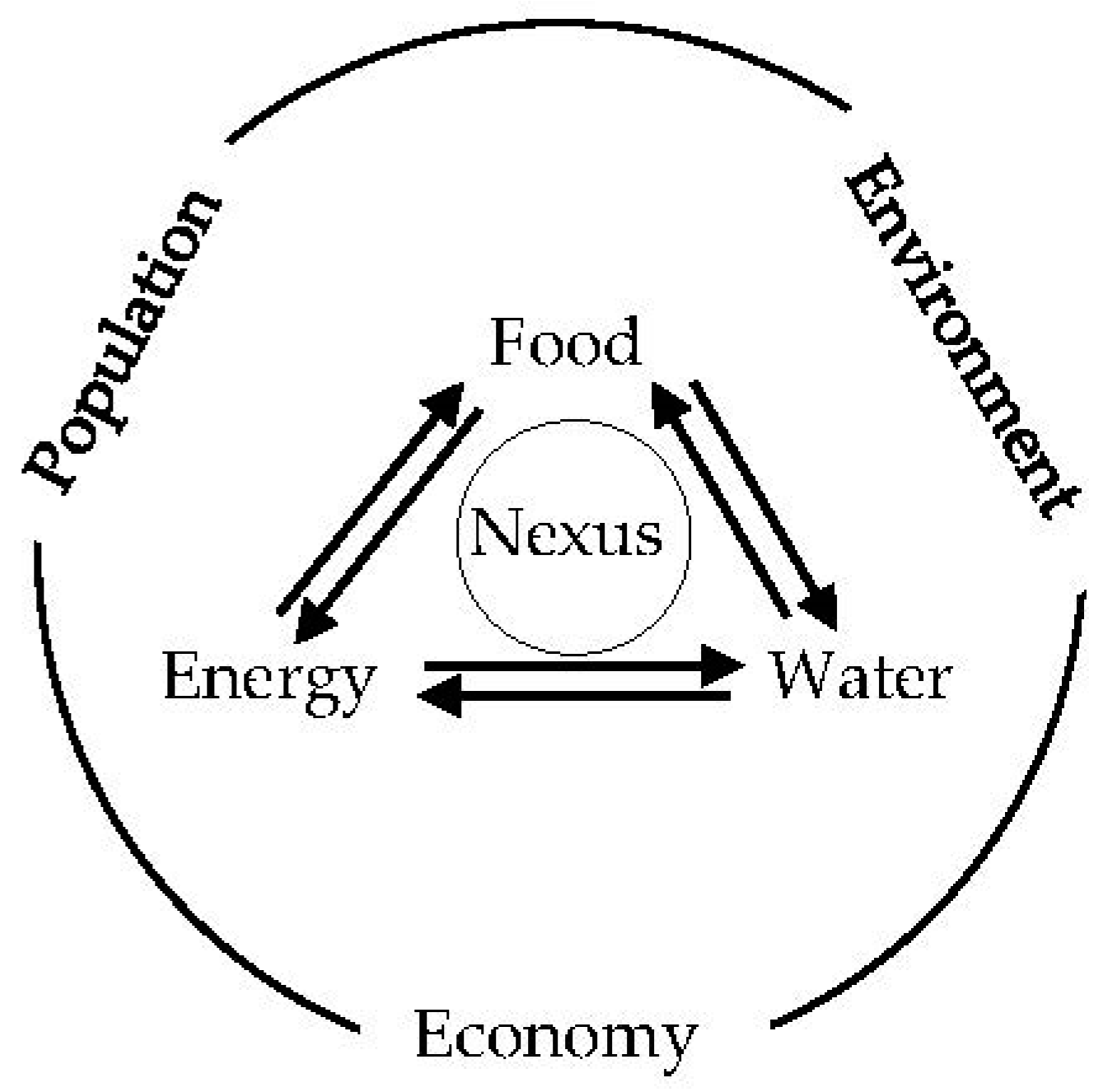
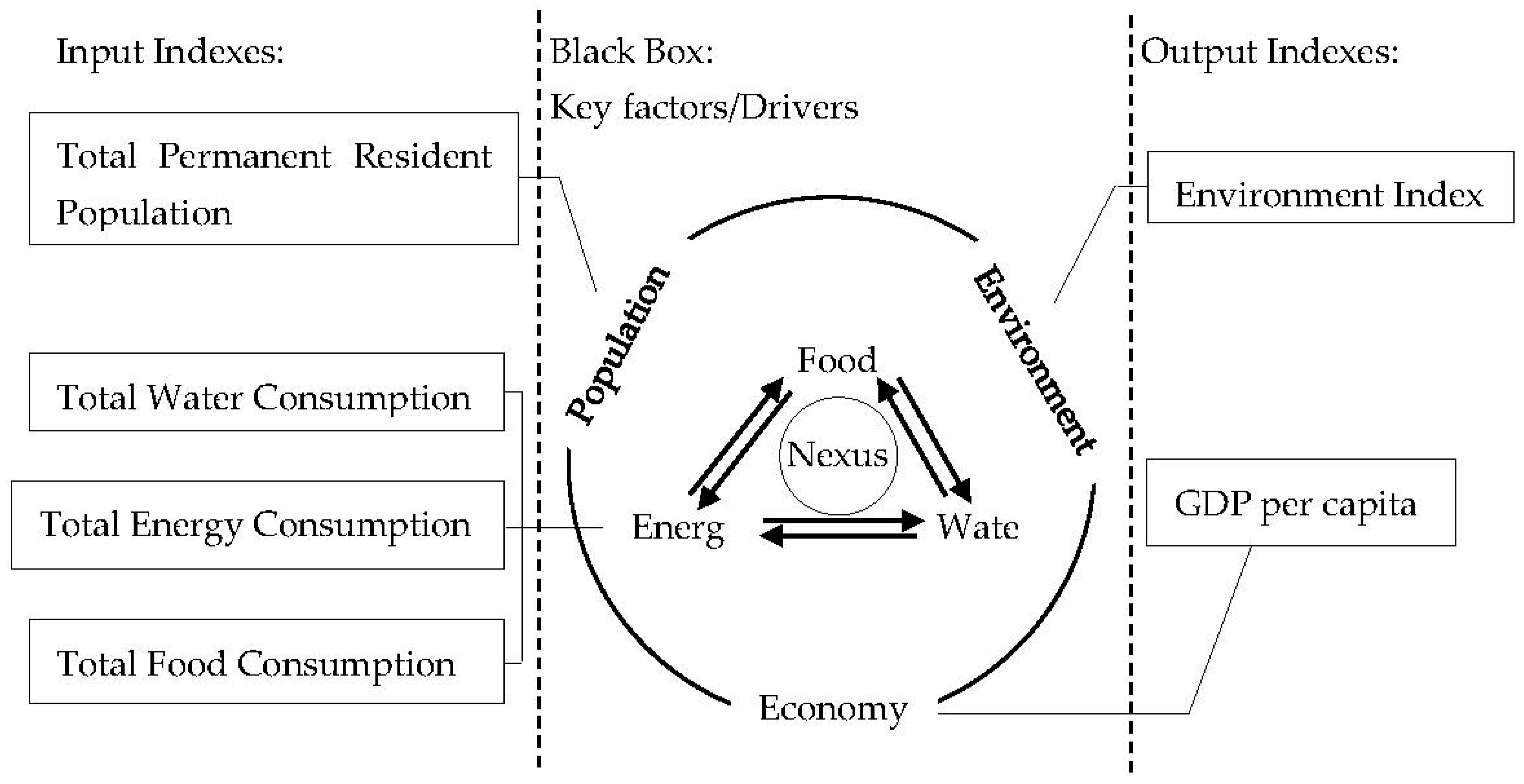
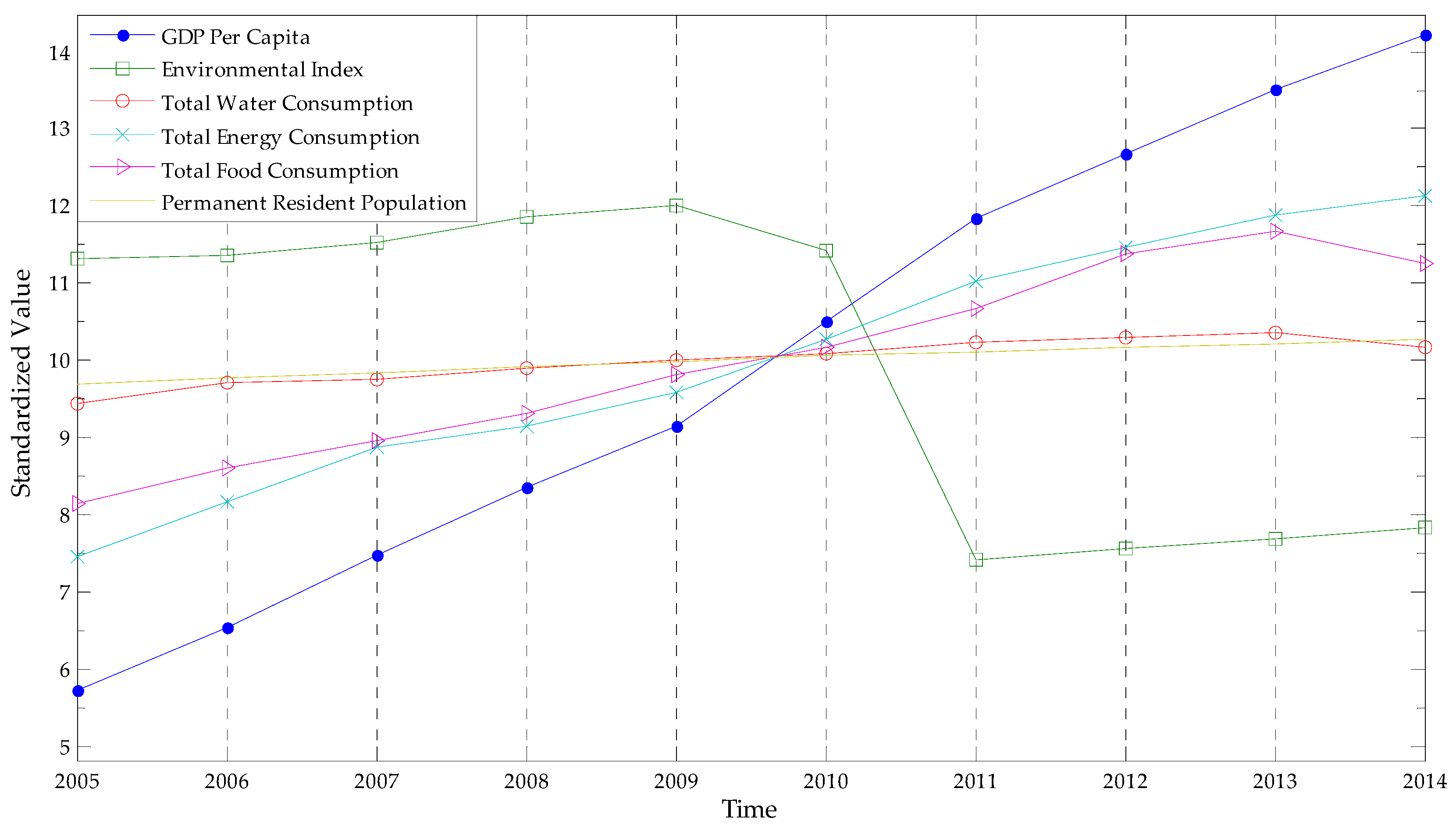
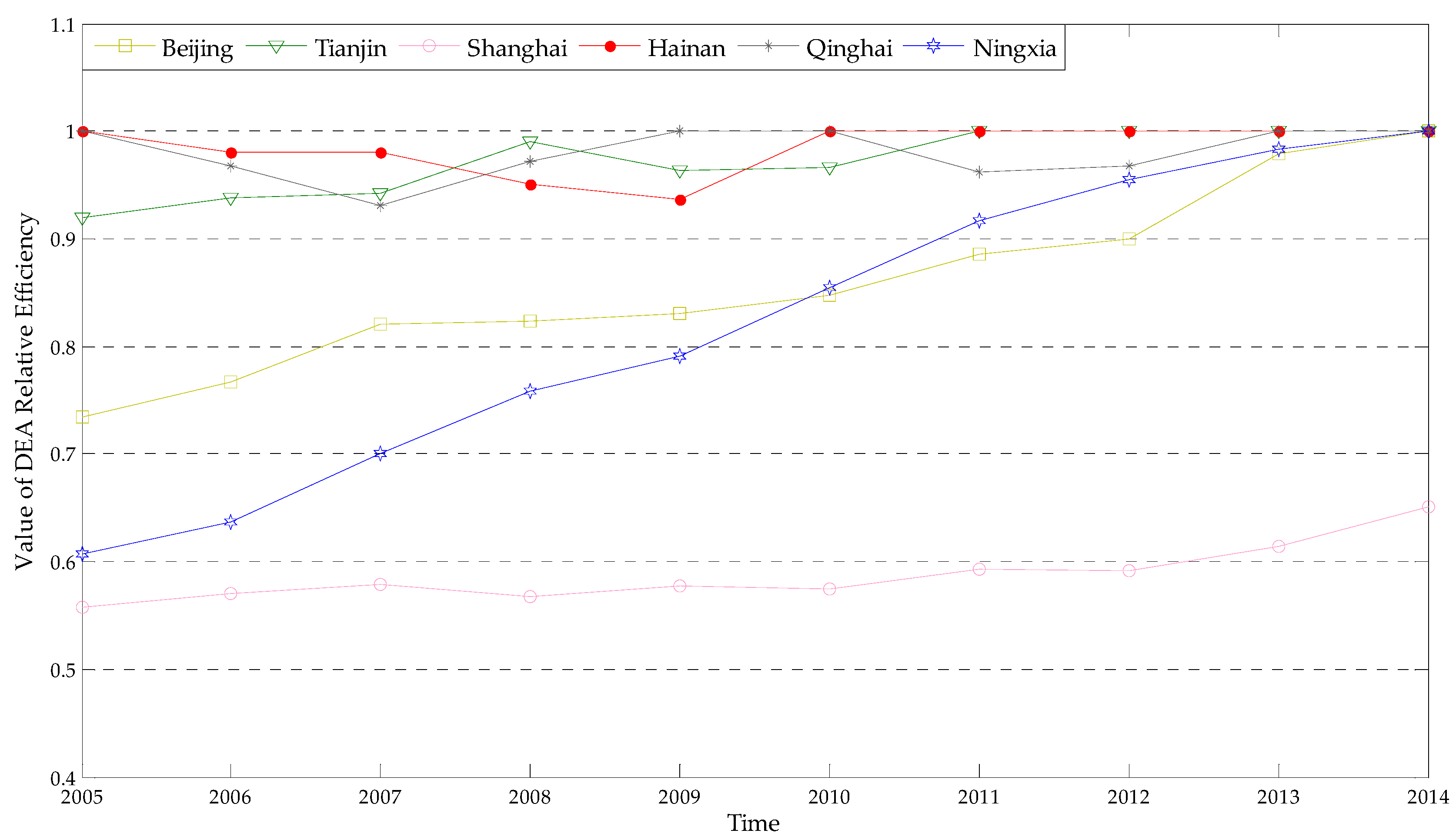

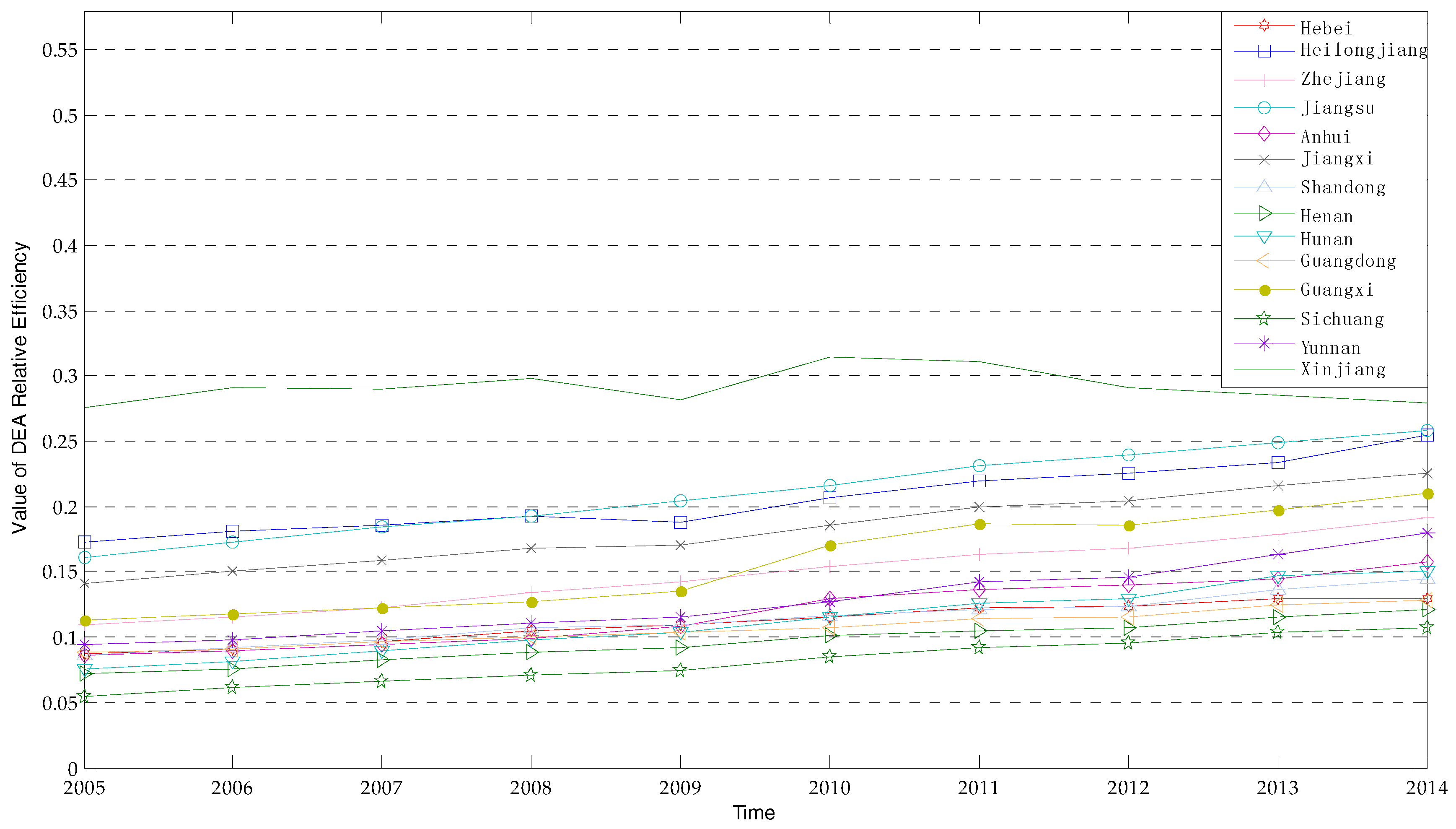
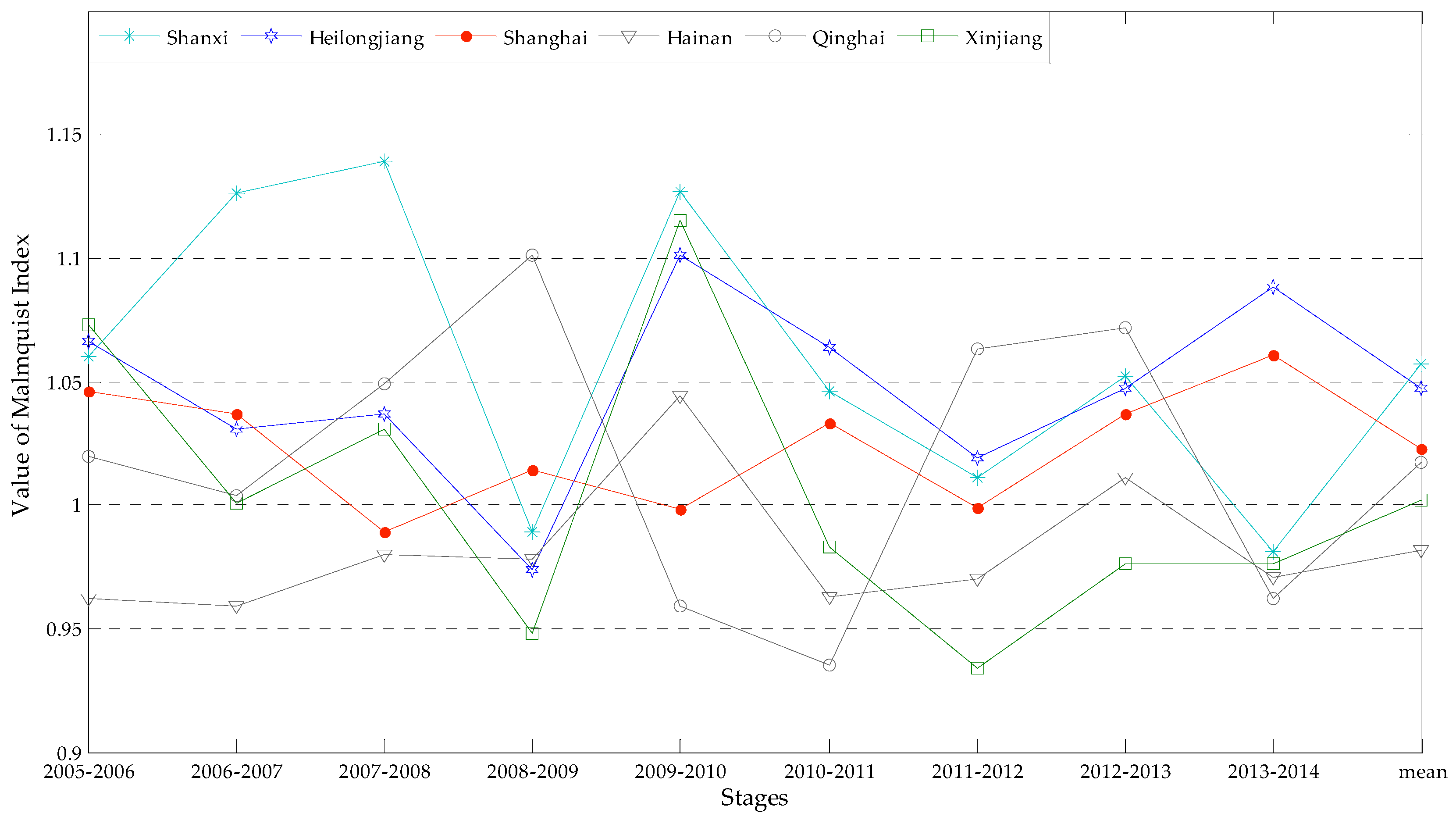
| Types | Indexes | Chinese Case | Units | |
|---|---|---|---|---|
| Input | Total Water Consumption | Total Water Use | 100 million m3 | |
| Total Energy Consumption | Total Energy Consumption | 10,000 tons of SCE | ||
| Total Food Consumption | Total Food Consumption Expenditures | 10,000 Yuan | ||
| Total Permanent Resident Population | Total Population at Year-end | 10,000 people | ||
| Output | GDP per capita | GDP per capita | Yuan per person | |
| Environment Index | Total Waste Gas | Total Volume of Sulphur Dioxide Emissions; Total Volume of Soot and Dust Emissions | 10,000 tons | |
| Total Waste Water | Total Waste Water Discharged | 10,000 tons | ||
| Total Solid Waste | Total Industrial Solid Wastes Produced | 10,000 tons | ||
| DMU | Regions | 2005 | 2006 | 2007 | 2008 | 2009 | 2010 | 2011 | 2012 | 2013 | 2014 |
|---|---|---|---|---|---|---|---|---|---|---|---|
| 1 | Beijing | 0.89 | 0.93 | 1 | 0.94 | 0.97 | 1 | 1 | 1 | 1 | 1 |
| 2 | Tianjin | 1 | 1 | 1 | 1 | 1 | 1 | 1 | 1 | 1 | 1 |
| 3 | Hebei | 0.12 | 0.12 | 0.13 | 0.13 | 0.13 | 0.14 | 0.13 | 0.13 | 0.13 | 0.13 |
| 4 | Shanxi | 0.23 | 0.23 | 0.25 | 0.27 | 0.27 | 0.28 | 0.27 | 0.27 | 0.27 | 0.26 |
| 5 | Inner Mongolia | 0.34 | 0.36 | 0.38 | 0.40 | 0.44 | 0.45 | 0.46 | 0.46 | 0.45 | 0.46 |
| 6 | Liaoning | 0.17 | 0.17 | 0.18 | 0.18 | 0.20 | 0.22 | 0.23 | 0.24 | 0.26 | 0.28 |
| 7 | Jilin | 0.26 | 0.28 | 0.30 | 0.31 | 0.34 | 0.36 | 0.39 | 0.41 | 0.45 | 0.47 |
| 8 | Heilongjiang | 0.20 | 0.21 | 0.21 | 0.21 | 0.21 | 0.22 | 0.23 | 0.24 | 0.24 | 0.26 |
| 9 | Shanghai | 0.72 | 0.71 | 0.70 | 0.64 | 0.63 | 0.63 | 0.64 | 0.63 | 0.62 | 0.65 |
| 10 | Jiangsu | 0.14 | 0.14 | 0.15 | 0.15 | 0.16 | 0.17 | 0.17 | 0.18 | 0.18 | 0.19 |
| 11 | Zhejiang | 0.22 | 0.23 | 0.24 | 0.23 | 0.24 | 0.25 | 0.26 | 0.26 | 0.25 | 0.26 |
| 12 | Anhui | 0.12 | 0.12 | 0.13 | 0.12 | 0.13 | 0.14 | 0.15 | 0.15 | 0.15 | 0.16 |
| 13 | Fujian | 0.27 | 0.28 | 0.29 | 0.29 | 0.31 | 0.32 | 0.33 | 0.33 | 0.34 | 0.34 |
| 14 | Jiangxi | 0.17 | 0.18 | 0.19 | 0.20 | 0.20 | 0.20 | 0.22 | 0.22 | 0.23 | 0.23 |
| 15 | Shandong | 0.10 | 0.10 | 0.11 | 0.11 | 0.12 | 0.12 | 0.12 | 0.13 | 0.14 | 0.15 |
| 16 | Henan | 0.08 | 0.09 | 0.09 | 0.10 | 0.10 | 0.11 | 0.11 | 0.11 | 0.12 | 0.12 |
| 17 | Hubei | 0.11 | 0.12 | 0.13 | 0.13 | 0.15 | 0.15 | 0.16 | 0.17 | 0.18 | 0.20 |
| 18 | Hunan | 0.10 | 0.10 | 0.11 | 0.12 | 0.12 | 0.13 | 0.14 | 0.14 | 0.15 | 0.15 |
| 19 | Guangdong | 0.13 | 0.13 | 0.13 | 0.13 | 0.13 | 0.13 | 0.13 | 0.13 | 0.13 | 0.13 |
| 20 | Guangxi | 0.14 | 0.15 | 0.16 | 0.16 | 0.17 | 0.19 | 0.20 | 0.20 | 0.21 | 0.21 |
| 21 | Hainan | 1 | 1 | 1 | 1 | 1 | 1 | 1 | 1 | 1 | 1 |
| 22 | Chongqing | 0.25 | 0.26 | 0.26 | 0.27 | 0.28 | 0.29 | 0.31 | 0.32 | 0.35 | 0.37 |
| 23 | Sichuan | 0.07 | 0.08 | 0.08 | 0.09 | 0.09 | 0.09 | 0.10 | 0.10 | 0.11 | 0.11 |
| 24 | Guizhou | 0.10 | 0.11 | 0.12 | 0.13 | 0.15 | 0.15 | 0.17 | 0.18 | 0.21 | 0.22 |
| 25 | Yunnan | 0.12 | 0.12 | 0.13 | 0.13 | 0.14 | 0.14 | 0.15 | 0.16 | 0.17 | 0.18 |
| 26 | Shaanxi | 0.20 | 0.21 | 0.22 | 0.24 | 0.25 | 0.27 | 0.29 | 0.30 | 0.30 | 0.34 |
| 27 | Gansu | 0.20 | 0.22 | 0.23 | 0.23 | 0.24 | 0.25 | 0.27 | 0.27 | 0.27 | 0.28 |
| 28 | Qinghai | 1 | 1 | 1 | 1 | 1 | 1 | 1 | 1 | 1 | 1 |
| 29 | Ningxia | 0.91 | 0.89 | 0.95 | 0.94 | 1 | 1 | 1 | 1 | 1 | 1 |
| 30 | Xinjiang | 0.38 | 0.37 | 0.35 | 0.33 | 0.31 | 0.33 | 0.33 | 0.30 | 0.29 | 0.29 |
| Regions | 2005 | 2006 | 2007 | 2008 | 2009 | 2010 | 2011 | 2012 | 2013 | 2014 |
|---|---|---|---|---|---|---|---|---|---|---|
| Beijing | 0.74 | 0.77 | 0.82 | 0.82 | 0.83 | 0.85 | 0.89 | 0.90 | 0.98 | 1.00 |
| Tianjin | 0.92 | 0.94 | 0.94 | 0.99 | 0.96 | 0.97 | 1.00 | 1.00 | 1.00 | 1.00 |
| Hebei | 0.09 | 0.09 | 0.10 | 0.11 | 0.11 | 0.12 | 0.12 | 0.12 | 0.13 | 0.13 |
| Shanxi | 0.16 | 0.17 | 0.19 | 0.22 | 0.22 | 0.24 | 0.25 | 0.25 | 0.26 | 0.26 |
| Inner Mongolia | 0.22 | 0.24 | 0.27 | 0.30 | 0.32 | 0.36 | 0.41 | 0.44 | 0.44 | 0.45 |
| Liaoning | 0.15 | 0.15 | 0.16 | 0.18 | 0.18 | 0.21 | 0.22 | 0.23 | 0.26 | 0.28 |
| Jilin | 0.22 | 0.24 | 0.26 | 0.29 | 0.30 | 0.34 | 0.37 | 0.38 | 0.43 | 0.46 |
| Heilongjiang | 0.17 | 0.18 | 0.19 | 0.19 | 0.19 | 0.21 | 0.22 | 0.23 | 0.23 | 0.26 |
| Shanghai | 0.56 | 0.57 | 0.58 | 0.57 | 0.58 | 0.58 | 0.59 | 0.59 | 0.61 | 0.65 |
| Jiangsu | 0.11 | 0.12 | 0.12 | 0.13 | 0.14 | 0.15 | 0.16 | 0.17 | 0.18 | 0.19 |
| Zhejiang | 0.16 | 0.17 | 0.18 | 0.19 | 0.20 | 0.22 | 0.23 | 0.24 | 0.25 | 0.26 |
| Anhui | 0.09 | 0.09 | 0.09 | 0.10 | 0.11 | 0.13 | 0.14 | 0.14 | 0.15 | 0.16 |
| Fujian | 0.19 | 0.20 | 0.21 | 0.23 | 0.25 | 0.27 | 0.29 | 0.31 | 0.33 | 0.34 |
| Jiangxi | 0.14 | 0.15 | 0.16 | 0.17 | 0.17 | 0.19 | 0.20 | 0.21 | 0.22 | 0.23 |
| Shandong | 0.09 | 0.09 | 0.10 | 0.11 | 0.11 | 0.12 | 0.12 | 0.12 | 0.14 | 0.15 |
| Henan | 0.07 | 0.08 | 0.08 | 0.09 | 0.09 | 0.10 | 0.11 | 0.11 | 0.12 | 0.12 |
| Hubei | 0.09 | 0.10 | 0.10 | 0.11 | 0.13 | 0.14 | 0.15 | 0.16 | 0.17 | 0.19 |
| Hunan | 0.08 | 0.08 | 0.09 | 0.10 | 0.10 | 0.12 | 0.13 | 0.13 | 0.15 | 0.15 |
| Guangdong | 0.09 | 0.09 | 0.10 | 0.10 | 0.10 | 0.11 | 0.11 | 0.12 | 0.13 | 0.13 |
| Guangxi | 0.11 | 0.12 | 0.12 | 0.13 | 0.14 | 0.17 | 0.19 | 0.19 | 0.20 | 0.21 |
| Hainan | 1.00 | 0.98 | 0.98 | 0.95 | 0.94 | 1.00 | 1.00 | 1.00 | 1.00 | 1.00 |
| Chongqing | 0.19 | 0.20 | 0.21 | 0.24 | 0.25 | 0.27 | 0.30 | 0.30 | 0.35 | 0.37 |
| Sichuan | 0.06 | 0.06 | 0.07 | 0.07 | 0.07 | 0.09 | 0.09 | 0.10 | 0.10 | 0.11 |
| Guizhou | 0.09 | 0.09 | 0.11 | 0.12 | 0.13 | 0.14 | 0.16 | 0.17 | 0.20 | 0.22 |
| Yunnan | 0.09 | 0.10 | 0.11 | 0.11 | 0.12 | 0.13 | 0.14 | 0.15 | 0.16 | 0.18 |
| Shaanxi | 0.16 | 0.18 | 0.19 | 0.22 | 0.22 | 0.25 | 0.28 | 0.28 | 0.30 | 0.33 |
| Gansu | 0.16 | 0.18 | 0.20 | 0.21 | 0.21 | 0.23 | 0.25 | 0.26 | 0.26 | 0.27 |
| Qinghai | 1.00 | 0.97 | 0.93 | 0.97 | 1.00 | 1.00 | 0.96 | 0.97 | 1.00 | 1.00 |
| Ningxia | 0.61 | 0.64 | 0.70 | 0.76 | 0.79 | 0.85 | 0.92 | 0.96 | 0.98 | 1.00 |
| Xinjiang | 0.28 | 0.29 | 0.29 | 0.30 | 0.28 | 0.32 | 0.31 | 0.29 | 0.29 | 0.28 |
| Stages | Shanghai M Value | Shanghai EC Value | Xinjiang EC Value | ||||||
|---|---|---|---|---|---|---|---|---|---|
| EC | TC | M Value | EC | PC | SC | EC | PC | SC | |
| 2005–2006 | 0.987 | 1.06 | 1.046 | 0.987 | 1 | 0.987 | 0.981 | 0.98 | 1 |
| 2006–2007 | 0.987 | 1.05 | 1.037 | 0.987 | 1 | 0.987 | 0.942 | 0.938 | 1.004 |
| 2007–2008 | 0.907 | 1.091 | 0.989 | 0.907 | 1 | 0.907 | 0.945 | 0.951 | 0.993 |
| 2008–2009 | 0.987 | 1.028 | 1.014 | 0.987 | 1 | 0.987 | 0.953 | 0.95 | 1.003 |
| 2009–2010 | 1.002 | 0.996 | 0.998 | 1.002 | 1 | 1.002 | 1.043 | 1.038 | 1.005 |
| 2010–2011 | 1.007 | 1.026 | 1.033 | 1.007 | 0.647 | 1.556 | 0.997 | 0.994 | 1.003 |
| 2011–2012 | 0.995 | 1.003 | 0.999 | 0.995 | 0.997 | 0.998 | 0.931 | 0.933 | 0.998 |
| 2012–2013 | 0.98 | 1.059 | 1.037 | 0.98 | 0.968 | 1.013 | 0.946 | 0.948 | 0.999 |
| 2013–2014 | 1.052 | 1.009 | 1.061 | 1.052 | 1.055 | 0.997 | 1.003 | 1.017 | 0.987 |
| Stages | Hainan | Qinghai | Xinjiang | ||||||
|---|---|---|---|---|---|---|---|---|---|
| EC | TC | M Value | EC | TC | M Value | EC | TC | M Value | |
| 2005–2006 | 1 | 0.962 | 0.962 | 1 | 1.02 | 1.02 | 0.981 | 1.094 | 1.073 |
| 2006–2007 | 1 | 0.959 | 0.959 | 1 | 1.004 | 1.004 | 0.942 | 1.063 | 1.001 |
| 2007–2008 | 1 | 0.98 | 0.98 | 1 | 1.049 | 1.049 | 0.945 | 1.091 | 1.031 |
| 2008–2009 | 1 | 0.978 | 0.978 | 1 | 1.101 | 1.101 | 0.953 | 0.995 | 0.948 |
| 2009–2010 | 1 | 1.044 | 1.044 | 1 | 0.959 | 0.959 | 1.043 | 1.069 | 1.115 |
| 2010–2011 | 1 | 0.963 | 0.963 | 1 | 0.935 | 0.935 | 0.997 | 0.985 | 0.983 |
| 2011–2012 | 1 | 0.97 | 0.97 | 1 | 1.063 | 1.063 | 0.931 | 1.003 | 0.934 |
| 2012–2013 | 1 | 1.011 | 1.011 | 1 | 1.072 | 1.072 | 0.946 | 1.031 | 0.976 |
| 2013–2014 | 1 | 0.971 | 0.971 | 1 | 0.962 | 0.962 | 1.003 | 0.972 | 0.976 |
© 2016 by the authors; licensee MDPI, Basel, Switzerland. This article is an open access article distributed under the terms and conditions of the Creative Commons Attribution (CC-BY) license (http://creativecommons.org/licenses/by/4.0/).
Share and Cite
Li, G.; Huang, D.; Li, Y. China’s Input-Output Efficiency of Water-Energy-Food Nexus Based on the Data Envelopment Analysis (DEA) Model. Sustainability 2016, 8, 927. https://doi.org/10.3390/su8090927
Li G, Huang D, Li Y. China’s Input-Output Efficiency of Water-Energy-Food Nexus Based on the Data Envelopment Analysis (DEA) Model. Sustainability. 2016; 8(9):927. https://doi.org/10.3390/su8090927
Chicago/Turabian StyleLi, Guijun, Daohan Huang, and Yulong Li. 2016. "China’s Input-Output Efficiency of Water-Energy-Food Nexus Based on the Data Envelopment Analysis (DEA) Model" Sustainability 8, no. 9: 927. https://doi.org/10.3390/su8090927






